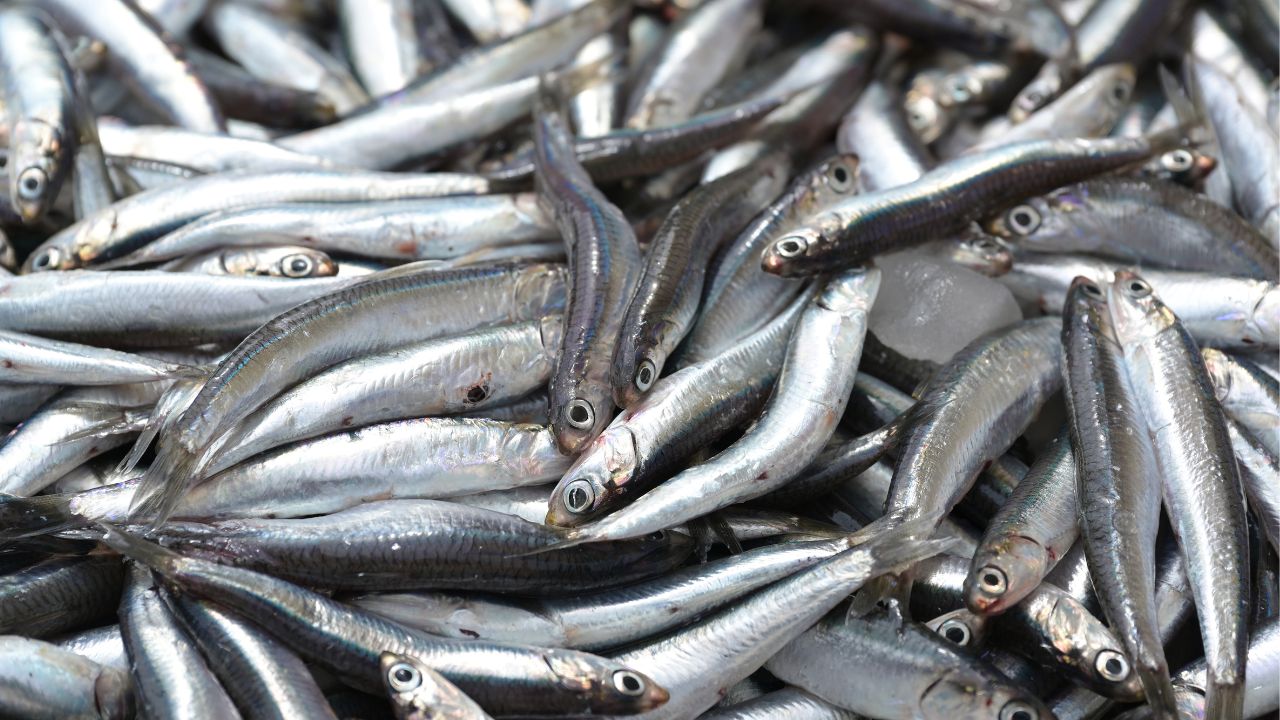Overfishing is a serious problem that is causing consequential damage to the oceans all over the world.
By looking at overfishing statistics, we can get an idea of how overfishing is harming our planet, the effects it has on fish and other marine life, and what will inevitably happen if we continue to push past the maximum sustainable yield.
From the amount of seafood we consume to the bycatch that fishermen throw away as waste, the figures that the human race is taking from the ocean are alarming, and if nothing changes, the world as we know it will be no more!
Fish and seafood are some of the most affordable animal proteins on the planet, and with their low cost comes high consumption figures. In record-breaking years, humans fished up to 179 million tons of seafood from the oceans, but what effect has that had on the sea life?
If overfishing continues, we could entirely wipe the oceans clean in under 30 years, and even if you aren’t here to see it, your children and your children’s children will suffer the effects of our generation.
Top 10 Most Disturbing Stats
- Almost 214 Million Tons of Fish and Seafood Is Produced Annually Around the World
- Almost 80% of the World’s Fisheries Are Already Depleted
- Top 20 Fisheries Producing Countries Account for 73% of the Total Fish Capturing
- 17% of Protein Sources Come From Fish
- Eastern Bluefin Tuna has Increased by 22%, and Western Bluefin Tuna Has Declined by 50%
- Almost 70% of the Shark Population Has Decreased Due to Fishing
- If No Measures Are Taken, the World’s Oceans Will Become Empty by 2048
- One-fourth of the Fish Catch Occurs Due to Trawling
- Asia Is Home to Many Fishers and Fish Farmers, Employing 50 Million People
- Fishing Subsidies Were Banned by WTO in July 2022
Fish Production Statistics
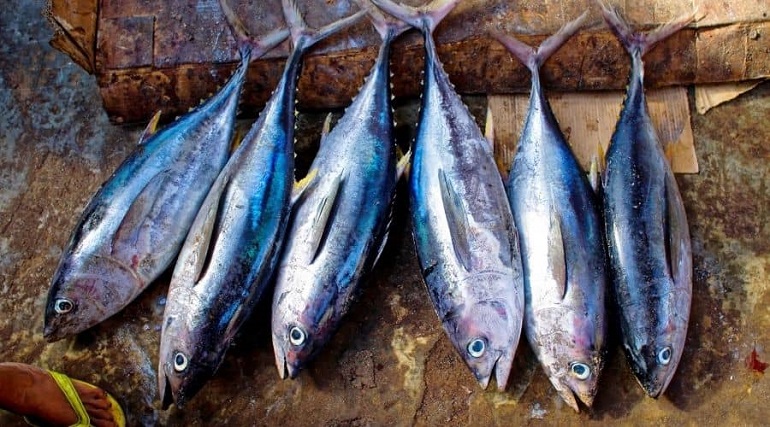
Almost 80% of the World’s Fisheries Are Already Depleted (The World Counts)
Humans are draining the world’s oceans at an alarming rate, and The World Counts estimates that we’ve already depleted almost 80% of the world’s fisheries. Fisheries management is crucial now more than ever if we don’t want to drain our oceans entirely of fish.
Fish Production Statistics From 2007 to 2016 Revealed Fisheries Captured 790 to 2,300 Billion tons of Fish (FAO)
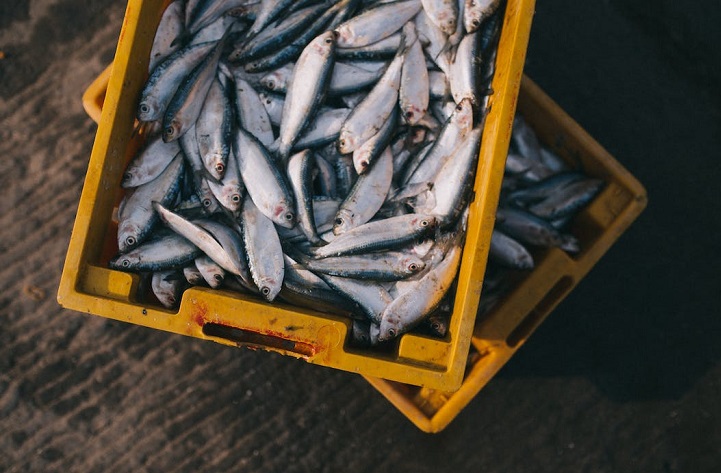
According to Fish Count, from the years 2007 to 2016, fisheries captured 790 to 2,300 billion tons of fish from the wild.
The Volume of Global Fish Production in 2022 Reached $184.6 Million Metric Tons (FAO, Statista)
As of 2022, the volume of global fish production crossed 184 million metric tons. In 2018, global fish production hit an all-time record as the FAO estimated that the world produced a whopping 179 million metric tons approximately of fish. Just under half of the total figure, 82 million tons, came from aquaculture alone.

250 to 600 Billion Crustaceans Were Killed in 2017 for Food (FAO, Fishcounts.org)
On top of the substantial amount of fish that we took out of the ocean in 2017, Fish Count also approximated that we additionally removed 250 to 600 billion farmed crustaceans simply for human consumption.
I think it’s easy to forget about crustaceans when discussing overfishing, but the damage and excessive catching we do to the invertebrates of the ocean are equally alarming.
As Per Latest Report of FAO, 214 Million Tons of Fish and Seafood Is Produced Annually Around the World (FAO)
It’s hard to think about how much fish and seafood is actually produced each year, but according to FAO, 214 million tons (including 178 million tons from aquatic animals and 36 million tons from algae) of seafood is produced annually.
According to Our World in Data, by a combination of wild fish catch and fish farming, the total is around 200 million tons worldwide. To put it into perspective, that’s the equivalent of 4 million male adult African elephants.
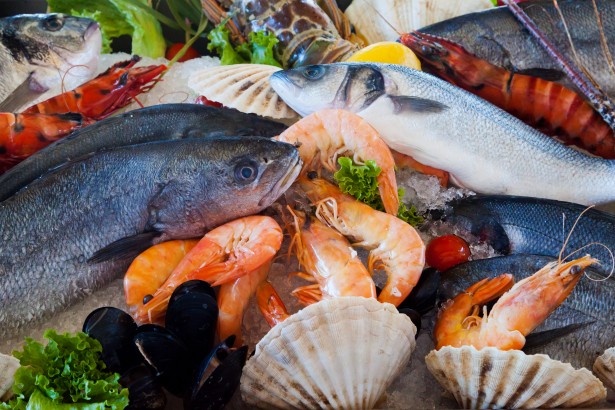
The most shocking part of it all, however, is that fish farms contribute a far greater percentage than fisheries. Aquaculture has accelerated rapidly over the past few decades, and we now get more fish from controlled cultivation than from the open ocean.
Top Seven Fisheries Producing Countries Account for 49% of the Total Fish Capturing (FAO)
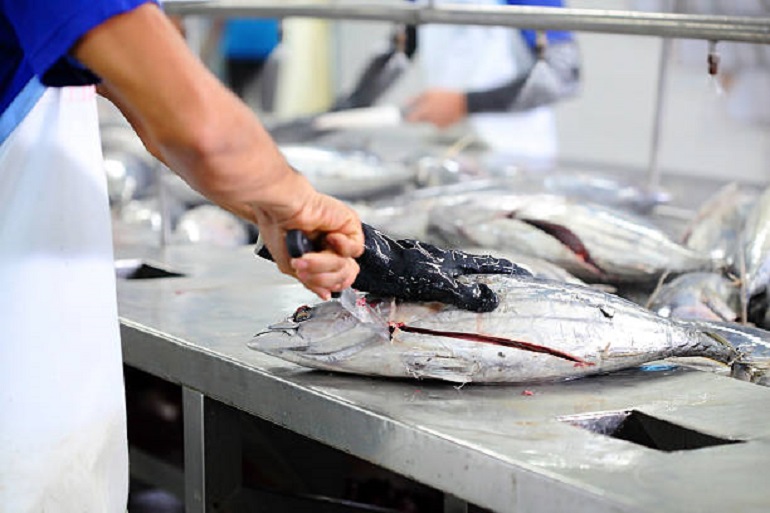
It’s crazy to think that only seven of the 195 countries in the world account for 49% of the global fish captures, but surprisingly, that’s the reality. The FAO ranks the top fishery-producing countries, with the world’s most populous country, China, taking the top spot with an astonishing 15%.
Following China are Indonesia and Peru, who each contribute 7%, India with 6%, Russia and the United States with 5% each, and Vietnam with 3%.
And yes, 3% may not seem like a lot, but 3% is actually over 5 million tonnes of fish.
Top 20 Fisheries Producing Countries Account for 73% of the Total Fish Capturing (FAO)
Although 49% of the total fish we capture around the world comes from seven countries, the FAO further highlights an additional 13 countries that contribute an extra 24%. This means that 73% of the total fish we capture worldwide comes from 20 countries alone.
Countrywide Fish and Seafood Production Statistics
Our world produces an astounding amount of around 200 million tonnes of fish and seafood every year.
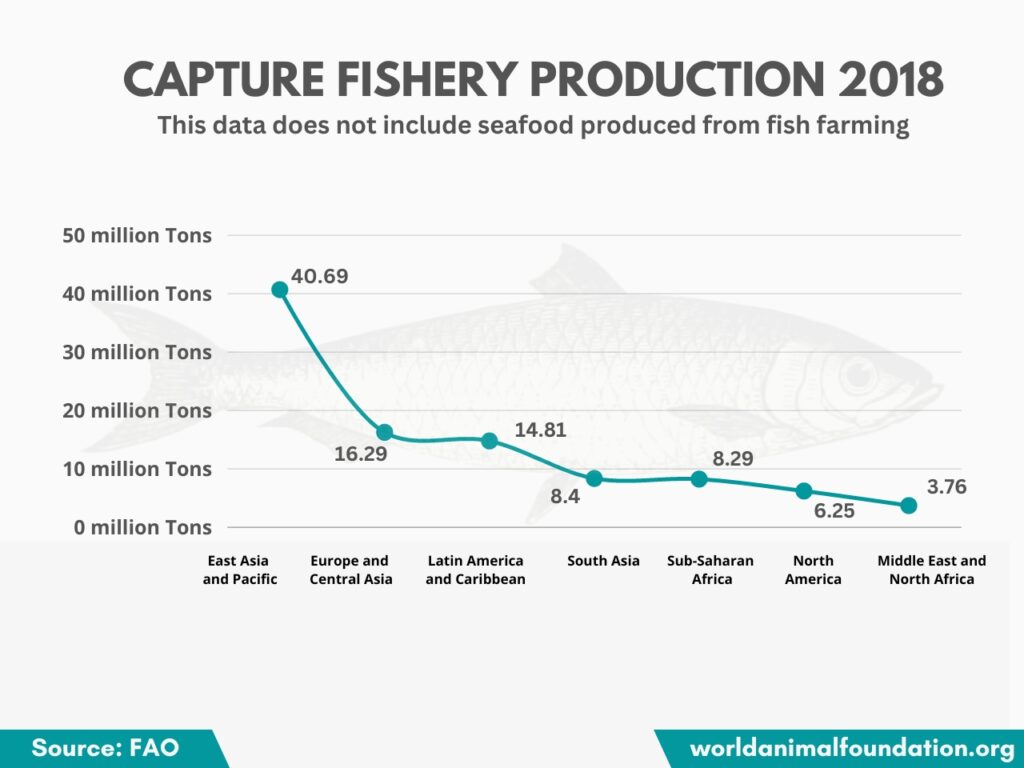
Fish Consumption Statistics
You may not think you personally eat a lot of seafood, but globally, fish consumption is on the rise, with people eating more seafood now than ever.
From 1961 to 2019, Global Fish Consumption Increased at an Annual Rate of 3% (FAO)

Humans are consuming more fish than ever, and the FAO has pointed out that the annual rate has increased by 3.0% from 1961 to 2019. If we continue this way, there will soon be no fish left to catch.
Food Fish Consumption Increased From 9.9 Kgs in the 1960s to 20.2 Kgs Per Capita in 2020 (FAO)
It’s no secret that people all over the world love to eat fish, but would you believe that in just over half a century, the FAO estimates that the average human’s fish consumption more than doubled from 9.9 kilograms in the 1960s to 20.3 kilograms in 2020?

A few reasons why fish consumption has increased is because of the health benefits that come with eating fish, the lower cost of fish compared to meat, and religious beliefs.
In 2020, 157.4 Million Tons Were Consumed by Humans (FAO)
In 2020, humans consumed almost 157.4 million tons of fish. 2018 saw the record for global fish production, with aquaculture and fisheries producing 179 million tons of fish throughout the year. The FAO estimates that a vast majority of that figure, roughly 159 million tones to be exact, we humans consume as food.
The Remaining 20.4 Million Were Used for Fishmeal and Fish Oil Production (FAO)

Aquaculture and fisheries produced 178 million tonnes of fish in 2020, and humans consumed 157.4 million tonnes, so where did the remaining 20 million tonnes go? Well, the FAO approximates that we used the remaining 20 million tonnes to create non-food items like fish oil and fish meal.
The Average Person Eats Nearly Twice As Much Seafood as a Half Century Ago (Sea Shepherd Global)
According to reported data, the health benefits and cost of seafood have resulted in people eating nearly twice as much as those a century ago. This huge increase in demand for seafood has ultimately upped fishing pressure and reduced global fish stocks.
17% of Protein Sources Come From Fish (FAO)
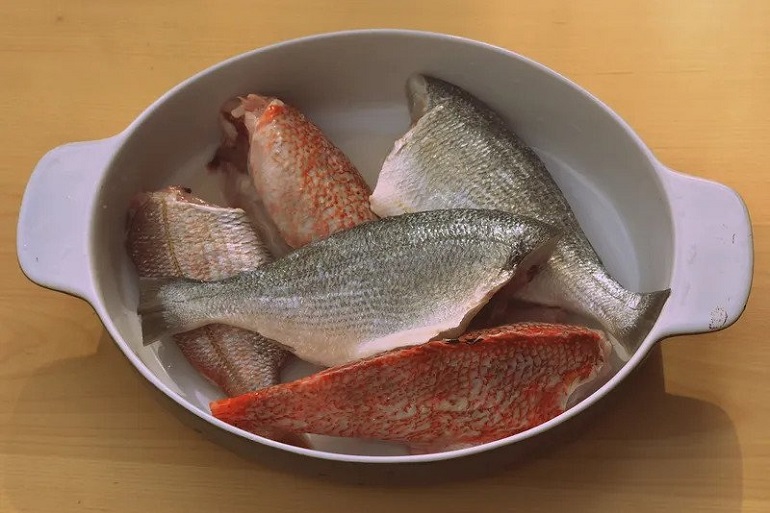
Globally, according to the FAO, 17% of animal proteins that humans consume come from fish, making it one of the leading protein choices.
70% of the Animal Protein in Cambodia Comes From Seafood (FAO)
A report by FAO suggests that in Cambodia, the vast majority of people rely on seafood to make up 70% of their total animal protein intake. Being a low-income country with many Cambodians living off a few dollars a day, it’s no surprise that the cheapest form of animal protein is Cambodia’s go-to source.
60% of the Animal Protein in Bangladesh and Maldives Comes From Seafood (Our World in Data)
Similarly to Cambodia, the people of Bangladesh have lower incomes, making seafood an affordable animal protein source.
Whereas for the Maldives, on the other hand, their high levels of seafood consumption are largely due to the fact that the inhabited Maldivian islands are completely surrounded by water, making seafood extremely accessible.
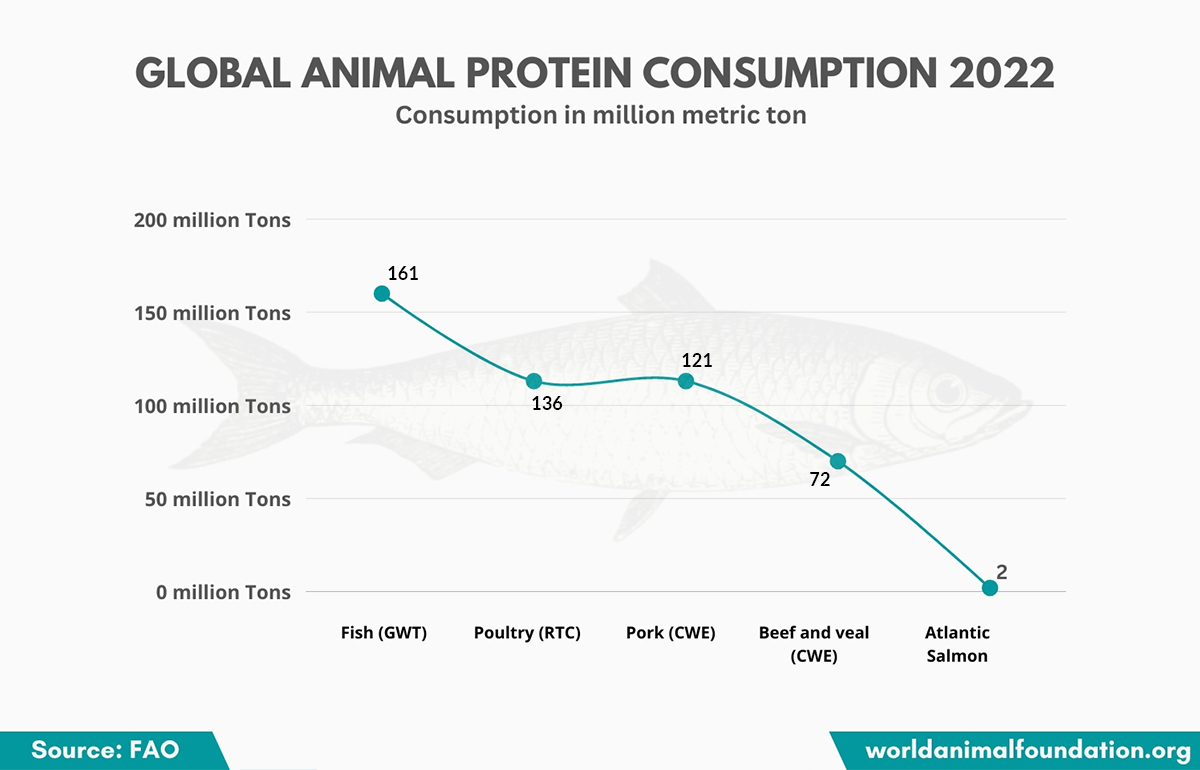
Most Threatened Fish Statistics
Atlantic Bluefin Tuna Has Been Classified As Endangered by the International Union for Conservation of Nature (IUCN)
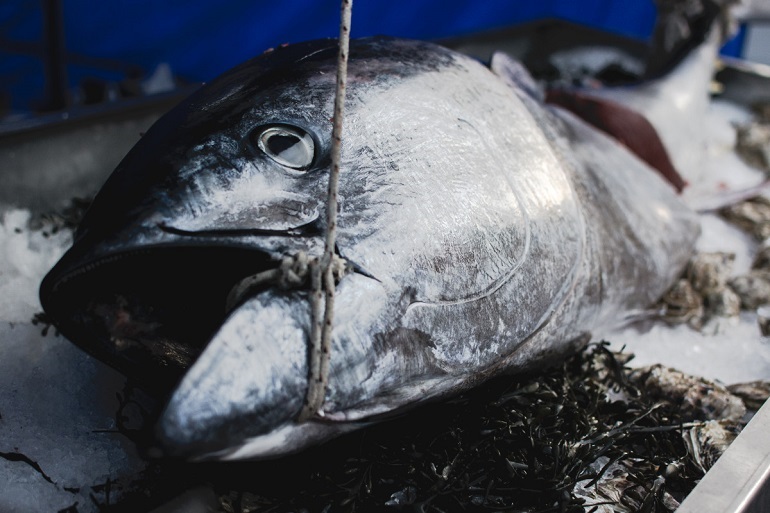
Many aquatic species have made their way onto the endangered list due to overfishing, and in 2011, the International Union for Conservation of Nature officially declared the Atlantic Bluefin Tuna an endangered species.
Luckily, the IUCN now states that tuna species are recovering, and their numbers are slowly on the rise.
Eastern Bluefin Tuna has Increased by 22%, and Western Bluefin Tuna Stock Has Declined by More Than 50% (IUCN)
Bluefin Tuna is the most expensive fish in the world, with many people considering it a delicacy. Sadly, thanks to its extremely high status all over the globe, Eastern and Western Bluefin Tuna fish stocks have decreased since 1970.
Efforts have recovered eastern bluefin tuna by 22%, but western bluefin tuna in the same period has declined by 50%.
The IUCN ‘Red List’ Also Included the European Eel in Its Critically Endangered Species (IUCN)
Shockingly, there are more than 150,000 species on the International Union for the Conservation of Nature red list, and in 2009, they declared the European Eel a critically endangered species, largely due to unregulated fishing and illegal exporting.
Almost 70% of the Shark Population Has Decreased Due to Fishing (Study Finds)
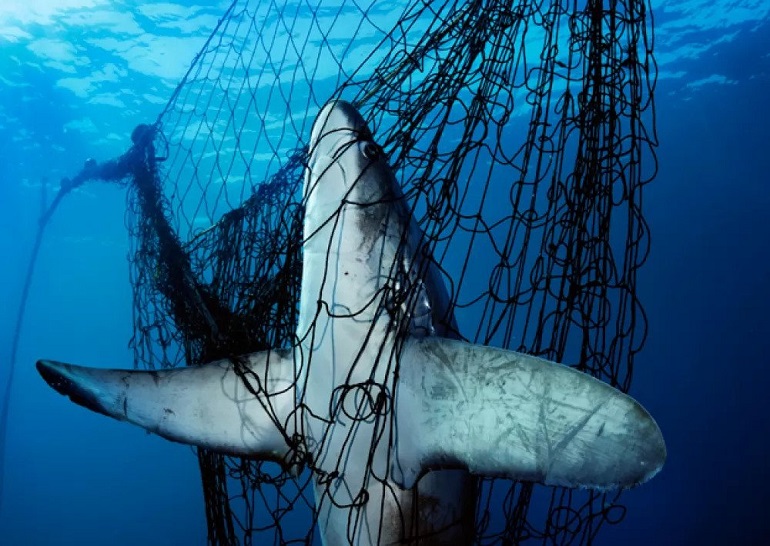
A study finds that overfishing and illegal finning of sharks has seen a staggering 70% of the entire shark population decrease. And if you thought that figure was shocking enough, it gets even worse when you understand the reason behind the substantial decrease.
All over Southeast Asia, people consider Shark Fin soup a status symbol, so fishermen capture sharks of all species, cut off their fins, and throw the finless sharks back into the water to die a slow and painful death.
More Than 25% of Sharks, Rays, and Skates Are Currently Threatened With Extinction, According to the IUCN Report of 2015 (IUCN)
Overfishing, bycatch, and the demand for shark fin soup have led to over 25% of skate, ray, and shark species being threatened with extinction, according to the IUCN. Once we lose these species, there is no getting them back, and eventually, we will throw off the ocean’s food supply chain entirely.
If No Measures Are Taken, Then by 2048, the World Oceans Will Become Empty (the World Counts)
The World Counts estimates that by 2048, if we keep fishing the way that we are, the human race could have completely emptied the oceans, wiping out seafood populations completely.
And I know that Sounds crazy, right? Well, it is, and we need to act now to ensure that marine life can flourish and continue to sustainably feed generations for centuries to come.
Methods Acquired for Fishing Statistics
Fishing is no longer a man with a rod sitting for hours hoping to catch fish. Today, fishers catch a high percentage of fish populations through damaging fishing practices like trawling and the deployment of large nets.
One-fourth of the Fish Catch Occurs Due to Trawling (NCBI)
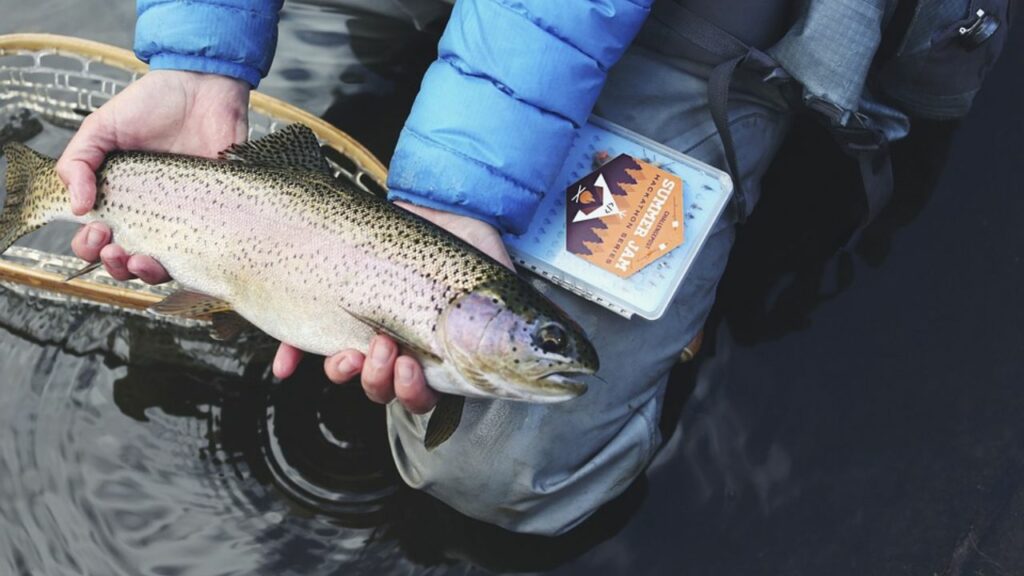
Trawling is by far one of the most harmful types of fishing, as boats drag heavy nets across the ocean floor in order to catch fish. Sadly, it is estimated that one-quarter of the world’s fish catch comes from trawling, which in turn only encourages the practice further.
Pelagic Trawling Accounts for an Additional 10% (Online Library Wiley)
Pelagic trawling is slightly different from standard bottom trawling as instead of dragging nets across the ocean floor, they drag the nets through the water to catch fish swimming in the mid and surface level of the ocean.
Although the nets for pelagic trawling aren’t damaging the ocean floor, they’re substantially bigger than bottom trawling nets, meaning they have the ability to catch larger amounts of fish at one time.
Purse Seining Accounts for More than 20% of Catch (Our World in Data)
Purse seining is where fishing boats use large walls of netting to capture an entire school of fish, and of all the world’s fish catch, this practice makes up for more than 20%, according to Our World in Data.
Gillnets and Longlines Account for Much Less of Global Fish Catch (Our World in Data)
Compared to trawling and purse seining practices, which capture extreme volumes of seafood at one time, gillnets, a vertical panel of netting, and longlines, a large number of hooked short lines attached to a longer main line, account for only a small portion of the global fish catch.
But, in saying that, gillnets and longline fishing methods are by no means better ways to fish, as both capture considerable amounts of bycatch, like sea turtles, sharks, and seals.
Employment in Fisheries and Aquaculture
Throughout countries all over the world, millions of people are employed in the fishing industry, whether that be in aquaculture or fisheries.
It Is Estimated That 58.5 Million People Globally Were Employed Either as Fishers or Fish Farming in 2020 (FAO)
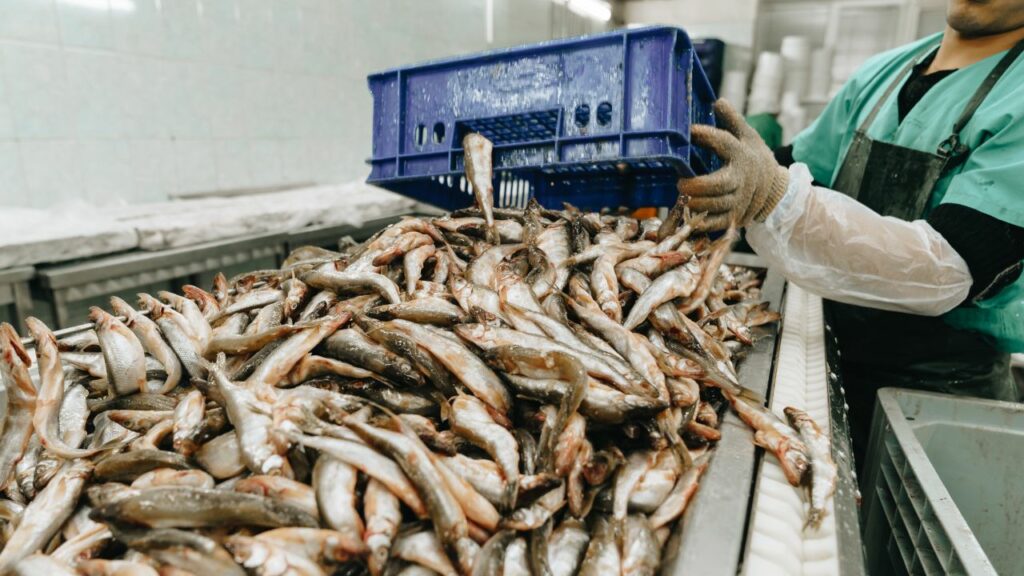
I’m sure it comes as no surprise, with the number of fish humans eat, that the industry has supplied millions of jobs to people all over the world. Our World in Data approximates that a staggering 58.5 million people, in 2020 alone, for example, were employed as fishers or workers on fish farms.
Asia Is Home to Many Fishers and Fish Farmers, Employing More Than 50 Million People (FAO)
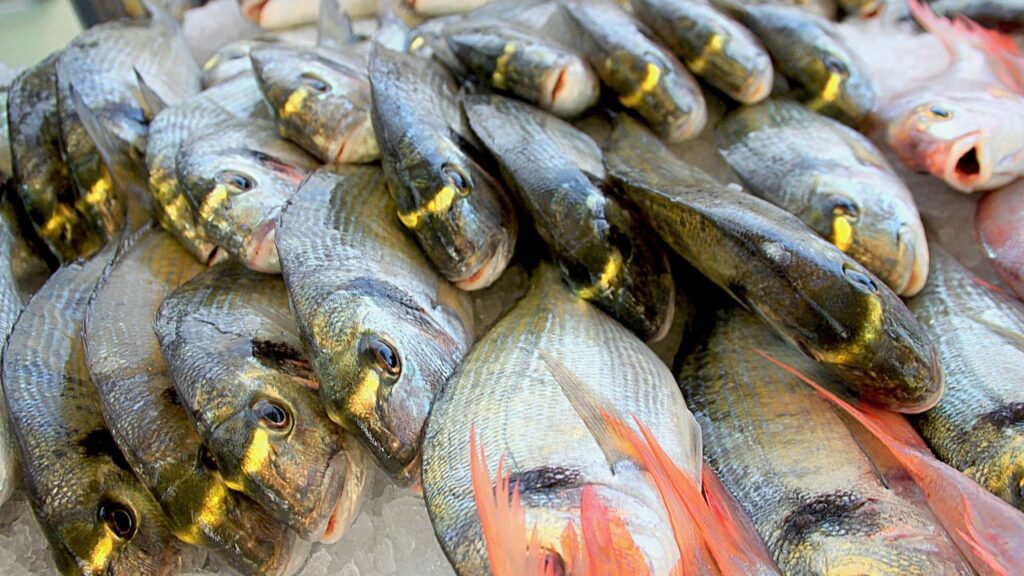
Unsurprisingly, considering five of the seven of the world’s top countries that account for 50% of the total global fish capturing are located in Asia, the Asian fishing sector employs around 50 million people.
More People Are Employed in Wild Catch than in Fish Farming, with a Difference of 39 Million to 21 Million (Our World in Data)
Although nearly half of the global fish production comes from fish farms, there is a significant difference in the number of people who work in aquaculture and the number who fish wild catch. Wild catch fishing employs 39 million people, whereas aquaculture employs considerably fewer, with 21 million people worldwide.
The Number of Fishers Across Europe Has More than Halved since Its Peak in 2000 (Global Fish Industry)
European employed fishers hit an all-time peak in 2000; however, since fishing communities across Europe have dwindled and the number of European employed fishers has more than halved, according to Our World in Data.
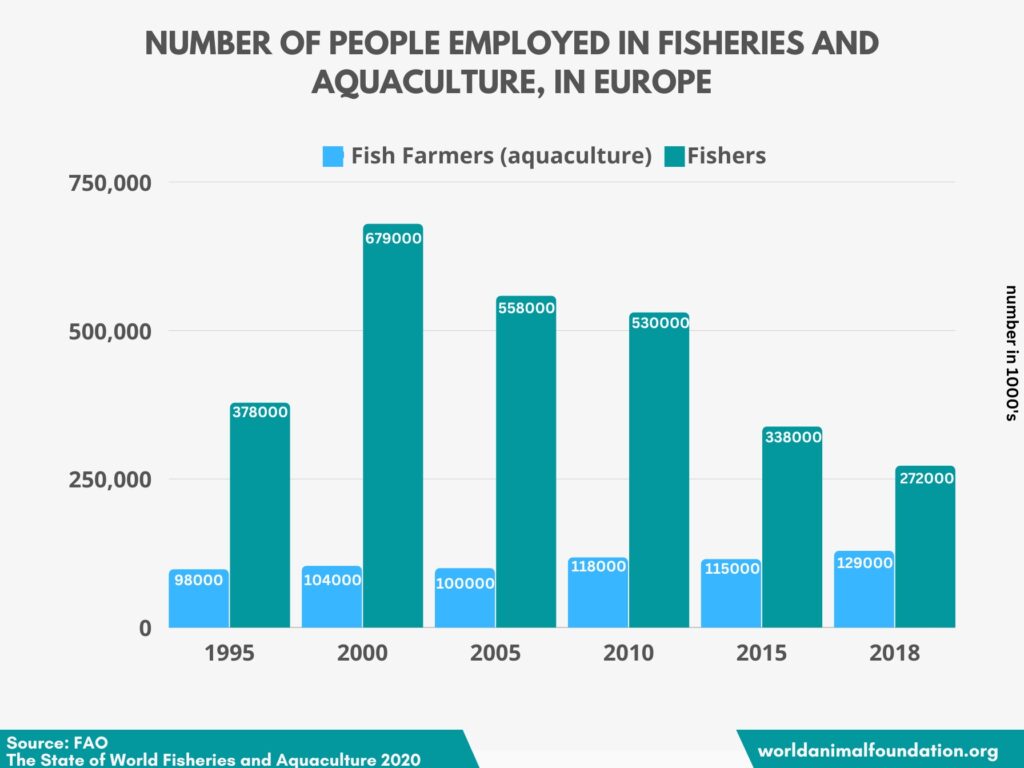
Overfishing Regulation Statistics
Regulating overfishing is no easy task, but organizations are coming together to implement sustainable fishing practices in an effort to save the world’s oceans and the species that call it home.
UN and FAO Are Working Together in Maintaining Sustainable Levels of Fish (UNO)
Luckily for the oceans and their aquatic inhabitants, the United Nations and the Food and Agriculture Organization have come together to devise a plan that will hopefully maintain a sustainable level of fish going forward.
In 2017, 34% of the Global Fish Stocks Were overfished, Two-thirds Were at Biologically Sustainable Levels, 60% Were Maximally Fished, and 6% Were Underfished. (Our World in Data)
Taking a look at global fish stocks from Our World in Data can give us insight into how our fishing is affecting fish species. In 2017, 34% of the global fish stocks were overfished, 60% were biologically sustainable or maximally fished, and 6% were underfished.
Fishing Subsidies Were Banned by WTO in July 2022 (WTO)
In an effort to reduce and discourage global overfishing and ultimately preserve the world’s oceans, in July of 2022, the World Trade Organization banned all fishing subsidies.
FAQ’s
What Is the Impact of Overfishing on Wildlife?
The biggest impact that overfishing has on wildlife is that by draining the ocean of fish, we create an imbalance and throw off the ocean’s food chain completely. Taking large amounts of certain fish species out of the ocean can lead to the extinction of more vulnerable aquatic animals, like sea turtles, for example.
Subsequently, losing species like sea turtles due to starvation then makes room for invasive species like jellyfish to take over the oceans.
How Much of the Seafloor Is Trawled?
It’s estimated that 14% of the seafloor is trawled, with trawlers continuing to churn up roughly 1.3% of the seafloor each year. Seafloor trawling, or bottom trawling, is when fishing vessels drag heavy nets and chains over the seafloor in order to catch fish.
Trawling not only directly diminishes the world’s fish stocks, but it also damages the coral and the habitats of marine species, causing further decline in fish populations.
What Can Be Done to Reduce the Impacts of Trawling?
The simplest and most effective way to reduce the impacts of trawling is to make trawling illegal, and some countries have even begun to put in place laws that prohibit trawling in marine protected areas in the hope of helping marine life and seabed recover.
But, as implementing laws on such a wide scale doesn’t happen overnight, there are a few ways we can reduce the impacts in an effort to make trawling more sustainable.
Putting in place management measures that ensure fishing gear modifications, limitations on the areas in which trawlers can fish, and the amount of fish they can catch will ultimately help reduce the overall impact of trawling.
How Much Feed for Aquaculture Comes From Fish?
A vast majority of the feed for Aquaculture comes from fish. Fish oil and fish meal make up most of the fish in a fish farm’s diet. Aquaculture also feeds off plants and animal trimmings; however, this is less common.
How Much Fish Is Used for Animal Feed?
On average, we take 18.9 million tons of wild-caught fish and create products like fish oil and fish meal, which we then feed to aquaculture, poultry, swine, and even household pets.
How Much Fish Is Discarded Yearly?
The Food and Agriculture Organization (FAO) estimates that 35% of global fish, mollusks, and crustaceans that the fishing industry catches from the ocean, lakes, rivers, and fish farms are discarded each year.
How Can Fish Discards Be Reduced?
Fishers discard fish for various reasons, with the most common being that the fish is smaller than the legal size, the fishermen have gone over their quota, the fish is damaged in some way, or it is prohibited to catch the fish species.
In order to reduce fish discards, there are a few things we can do, starting with implementing bycatch management planning.
Improving fishing gear to ensure fishers only capture a certain species, closing fisheries where fishermen discard a high percentage of unwanted marine life, implementing catch limits to control how much seafood is being caught, and monitoring all boats that commercial fisheries use are other ways that can significantly reduce fish discards.
How Much of the World’s Ocean Is Protected?
The ocean covers roughly 70% of the Earth’s surface, and of that 70%, just over 8% is protected.
Conclusion
Overfishing is a serious issue that we need to address, and by taking just one look at overfishing statistics, anyone can see the harm we’re doing to the oceans and their fish stocks.
Global seafood production is increasing at alarming rates, and the damage we’re doing to our oceans and their vital ecosystems is guaranteed to have detrimental effects not just on marine life but also on the human race. Without seafood, people will starve, and ultimately, the world as we know it will be no


